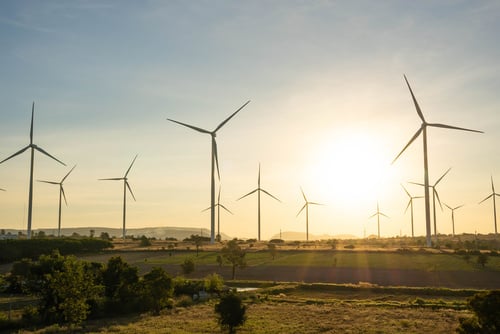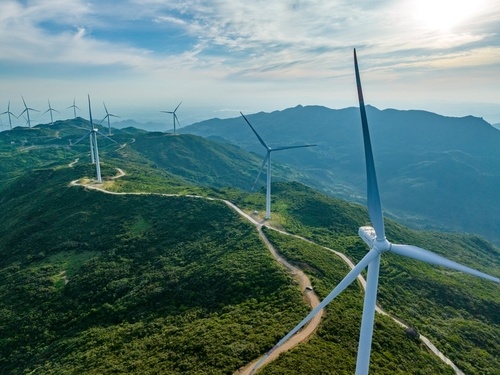Demand
Both the UK and Europe have experienced a mild and windy winter to date. As mentioned in our previous update, several weather forecasting models had suggested a mild, windy, and wet winter for Northwest Europe, and this has certainly materialised. The December cold snap did correlate with some increased demand, but this was short lived and demand in each month has been well below the three-year average, even below levels seen during the pandemic.
Whilst mild, windy conditions have supressed gas demand for both heating and power generation, as both industrial and domestic users faced their first winter of elevated prices, there is clear evidence price levels have reduced demand.
Our caution for potential cooler weather in both the US and North Asia also emerged. La Nina reached its peak in early winter which brought record snowstorms to the US in December. China, Japan and South Korea also experienced cold conditions which has supported gas demand.
Over the next few months, we expect gas demand to remain below averages, particularly if global economic conditions worsen and a recession emerges. Whilst prices have fallen in recent weeks, they still sit well above multi-year averages and will continue to incentivise demand destruction. Continued low demand for the remainder of winter could also lead to further price decreases over the summer period as less gas will be required to top up storages for the 2023/24 heating season.
Supply
Strong LNG supplies have been a feature throughout the winter so far. Europe’s year on year demand for LNG rose over 68% in 2022 as the region continued it’s push away from Russian gas. Healthy LNG arrivals are expected to continue for the remainder of winter with 7 LNG cargos due into the UK by the end of January and 4 already scheduled to arrive by mid-February. US LNG exports to Europe in 2022 rose almost 240% on 2021 levels, a significantly higher increase than any other region the US exports to. The US managed to increase output despite the Freeport LNG facility remaining offline following a fire in June 2022. Dates for the return of the facility have consistently been pushed back with the latest reports suggesting a February restart.
Whilst the increase in LNG has been welcome for Europe, rising domestic US gas prices, resulting from increased gas demand for liquefaction, remain a concern as a sensitive political issue. The impact of any policy or government change could signal a change to export levels in the future. Europe will also need to closely watch Asian demand for gas as China continues to relax covid measures in order to jump start its economy. Asian LNG prices have traded at a premium to both UK and European hubs since late December. A continuation or strengthening of this pattern could begin to incentivise LNG Eastwards.
Increased flows from Norway have also supported Europe’s effort to wean off Russian gas. Exports in 2022 were up 3.3% on 2021 and 10% on 2020 levels. Germany alone received 11% more gas from Norway YOY and additional demand came from the new Baltic pipe. The UK received almost 12% less gas than in 2021, however, strong LNG arrivals and mild weather have easily closed the gap. The Norwegian maintenance schedule is heavier for summer 2023, as some projects were delayed in summer 2022 to maximise gas flows to Europe ahead of winter 2022/23. Any impact on prices could be mitigated if storage levels remain healthy at the end of winter. NWE storages are currently on track to end winter at 12-year highs, currently sitting over 80% full, with UK currently over 90% full.
French nuclear capacity has continued to strengthen as winter has progressed with the country returning to a net exporter in January. Currently over 70% of capacity is online after falling to 30-year lows in summer 2022. Earlier in January, the head of France’s nuclear operator, RTE, said ‘most of the risks are behind us’ but did warn that ongoing strikes could pose risks to maintenance and repair projects.
Geopolitical Risk/Europe plans
Following a volatile 2022, the geopolitical picture for Europe’s energy supply remained relatively calm for the final quarter of 2022 and into 2023. Flows via the main remaining Russian route into Europe, via Ukraine, have fallen in recent weeks. Flows have persisted around the 400GWh/day mark since May 2022, however this has steadily fallen to closer to 200GWh/day currently. The fall in flows is likely due to decreased European nominations on the back of falling demand and strong LNG supply. Russia remains incentivised to continue sending gas via this route, since it’s exports to Europe have fallen considerably and infrastructure to send the same volumes of gas elsewhere is not yet in place.
Meanwhile, Germany has made huge progress in it’s move away from Russian gas. It’s first Floating Storage and Regassification unit went live in December 2022, with another since coming online. A third unit will go live imminently and a further 3 units are planned. Despite this significant progress, Germany will need to increase its volume of long-term LNG contracts to provide more security. With spot cargos incentivised by hub prices, Europe could find itself exposed if other global hub prices spike, as we saw in January 2021.
Wider Energy Complex
Many major economies increased interest rates in an effort to control record inflation in the second half of 2022. This has fuelled concerns of a global recession in 2023, however, in recent weeks the picture has been changing. China continues to relax its strict covid rules and the positive effect on the country’s economy should boost European trade. Europe’s economies will also benefit from the recent fall in wholesale energy prices. In the UK, the front seasonal gas and power contracts fell in excess of 50% from mid-December to mid-January, a welcome relief for many businesses.
Oil prices have responded to the more positive economic outlook. Brent crude oil prices have risen over 7% since the beginning of 2023. As the worlds largest consumer of oil, China’s reopening will likely continue to support prices, with further support expected from Europe’s Russian oil price cap effective from 5th Feb.
Carbon prices have remained rangebound for much of winter with lower resistance at €65 and upper resistance at €90 during December’s cold snap. Mild weather, demand destruction and economic fears have generally kept prices in check but periods of cold weather and low renewable output have resulting in price spikes. The European Commission is likely to present its proposals for electricity market reform in February or March, with the aim of decoupling gas from power price setting in Europe. The additional of maritime transport to the EU ETS, although gradual, is also likely to support prices for permits from 2024 towards.






